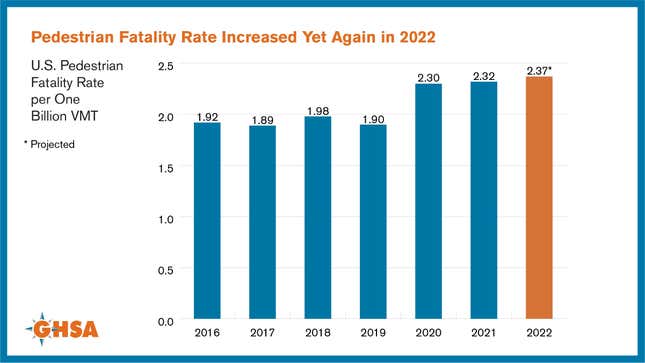
Cars are great and all, but there’s no getting around the fact that piloting a 4,000-pound hunk of metal can be dangerous. Both to people in other cars, as well as people who aren’t in cars. Unfortunately for pedestrians in the U.S., while other developed countries continue to get safer, the U.S. continues to get more dangerous. And last year, pedestrian deaths rose to a level not seen since the E28 BMW 5 Series was introduced.
The Governors Highway Safety Association’s latest report claims that drivers killed at least 7,508 pedestrians in the U.S. in 2022. That’s disturbing enough on its own, but it gets worse when you learn that since 2010, pedestrian deaths have jumped 77 percent, while 25 percent for all other traffic-related deaths. So while our roads have gotten more dangerous overall, they’re particularly dangerous for pedestrians. Additionally, the pedestrian fatality rate per billion miles traveled increased yet again from 2.32 to 2.37.

The report includes data from 49 states, as well as Washington, D.C. but due to a claimed technical issue, it does not include Oklahoma. Using past data from Oklahoma, it’s likely that the actual total number of pedestrians killed last year is at least 7,600.
“Every day, 20 people go for a walk and do not return home. These are people living their daily lives – commuting to and from school and work, picking up groceries, walking the dog, getting some exercise – who died suddenly and violently,” said GHSA Chief Executive Officer Jonathan Adkins in a statement. “The saddest part is that these crashes are preventable. We know what works – better-designed infrastructure, lower speeds, addressing risky driving behaviors that pose a danger to people walking. We must do these things and more to reverse this awful trend and protect people on foot. Enough is enough.”

And while it’s easy to blame these increases on both drivers and pedestrians using their cell phones, it’s important to remember that other developed countries have cell phones, too. Yet, they’re not seeing the same increases in pedestrian deaths. If we want to actually make our roads safer, we’re going to have to do more than complain about cell phone use. Unfortunately for drivers, that likely means making changes that don’t necessarily prioritize moving as many cars as fast as possible from one place to another, especially in areas where pedestrians are present.
The good news is, the report also highlights several things that different states are doing to actually get us there. For example, Florida passed a law in 2021 that requires the state driver education test bank to include at least 25 questions that are focused on bicycle and pedestrian safety. And Hawaii has begun working with homelessness outreach coordinators to get feedback on areas of concern and traffic calming measures. Several other states, including California, Maine, New Jersey, and South Carolina have also started using plainclothes officers to identify drivers who don’t yield to pedestrians in crosswalks so officers stationed down the road can stop them.
States are also changing their infrastructure to make it safer for pedestrians. They’re adding road diets to force drivers to slow down, as well as pedestrian refuge islands in crosswalks and better lighting and signage to increase visibility.
None of these are perfect solutions, but they can definitely help. In fact, a large number of states were actually able to reduce the number of pedestrian fatalities between 2021 and 2022. So while Arizona, Virginia and Oregon saw fatalities increase by at least 40 year-over-year, California, South Carolina and New Jersey saw at least 20 fewer fatalities. In fact, more states saw lower total fatalities than those that saw an increase.
If you’re interested, you can read the whole GHSA report here.